Red light therapy's specific wavelengths (630-850nm) can transform your sleep quality in multiple science-backed ways. You'll experience increased melatonin production, helping regulate your natural sleep-wake cycle. It resets disrupted circadian rhythms, especially beneficial for jet lag or shift work. Your brain waves optimize for deeper, more restorative rest while reducing inflammation and cortisol levels. The therapy enhances cellular recovery during sleep, improves athletic performance through better rest, and reduces stress-related sleep issues. By timing your exposure correctly, you'll see reduced sleep latency and improved sleep duration. These proven benefits only scratch the surface of red light therapy's sleep-enhancing potential.
Melatonin Production Benefits
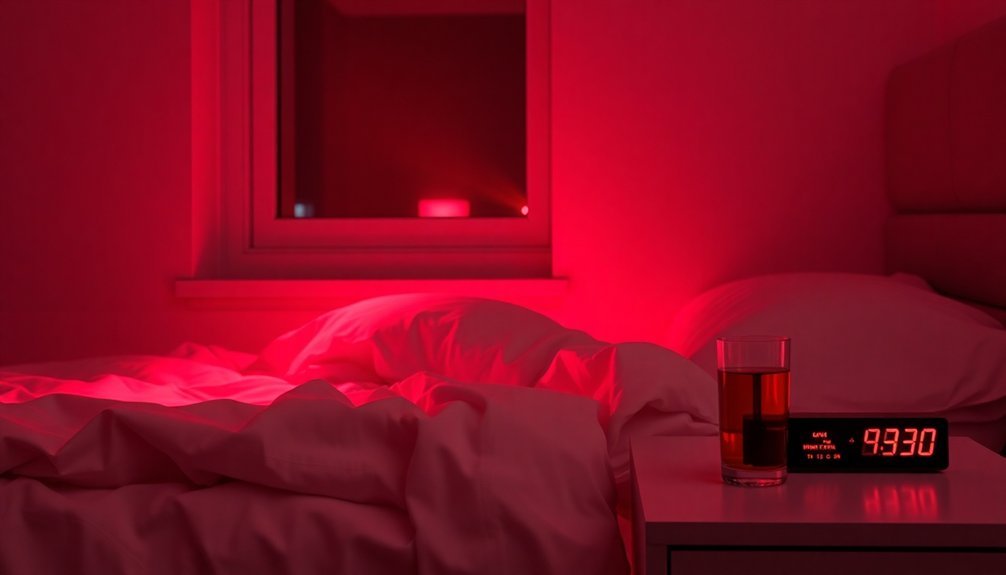
Through extensive research, red light therapy has shown promising effects on melatonin production, the hormone responsible for regulating your sleep-wake cycle. Unlike white or blue light from electronic devices, red light wavelengths don't disrupt your natural circadian rhythm. Instead, they stimulate your body's melatonin production, helping you fall asleep more easily.
Studies have demonstrated that exposure to red light can enhance your melatonin levels, leading to improved sleep quality. A notable 2019 study found that combining red light with ambient white light in the afternoon positively affected participants' circadian rhythms and increased their alertness during waking hours. However, it's important to note that overly bright red light can actually suppress melatonin production.
Additionally, red light exposure triggers the release of endorphins, which help you relax and prepare for sleep.
While more research is needed to fully understand the mechanisms at work, the current evidence suggests that incorporating red light therapy into your evening routine could transform your sleep experience. You'll likely find it particularly beneficial if you struggle with insomnia or irregular sleep patterns.
When combined with other sleep hygiene practices, red light therapy offers a natural approach to optimize your melatonin production and enhance your overall sleep quality.
Circadian Rhythm Reset
Your body's natural sleep patterns can be reset through strategic exposure to red light therapy in the evening hours.
When you're looking to resynchronize your internal clock, red light exposure proves particularly beneficial as it promotes melatonin production without disrupting your circadian rhythm like blue light does.
You'll find that consistent evening red light therapy sessions help restore your body's natural sleep-wake cycle, making it easier to fall asleep at night and wake up refreshed in the morning. The therapy works by influencing the suprachiasmatic nucleus in your brain, which acts as your master biological clock.
Natural Sleep Pattern Restoration
In accordance with our natural biology, restoring healthy sleep patterns requires realigning your body's internal clock with environmental light-dark cycles. Your suprachiasmatic nucleus (SCN) relies on consistent light exposure to regulate melatonin and cortisol production, which controls your sleep-wake rhythm.
When you expose yourself to natural sunlight during the day and minimize artificial light at night, you're supporting your body's innate timing system. Keeping your bedroom between 65 and 72 degrees is essential for optimal sleep quality.
To reset your natural sleep patterns, you'll need to create an environment that mirrors the sun's natural progression. Start by maintaining a consistent sleep schedule and incorporating these science-backed practices:
- Get 15-30 minutes of morning sunlight exposure to signal your SCN it's time to be alert and suppress melatonin production
- Engage in physical activity during daylight hours to promote natural tiredness aligned with your circadian rhythm
- Use amber lighting in the evening and avoid blue light exposure at least 2 hours before bedtime
Support your body's restoration process by creating a tranquil evening environment. Dim your lights, practice relaxation techniques, and maintain a cool, quiet bedroom setting.
Remember that consistency in these practices strengthens your natural sleep-wake cycle over time.
Evening Light Exposure Benefits
Strategic evening light exposure plays a vital role in resetting your circadian rhythm and optimizing sleep quality. When you're exposed to the right type of light in the evening, particularly red light, you'll experience improved sleep duration and enhanced performance during night hours. This is especially beneficial if you're a shift worker trying to maintain alertness while adapting to unusual schedules.
While blue light can disrupt your sleep by suppressing melatonin production, red light offers a gentler alternative that won't interfere with your natural sleep-wake cycle. Research shows that long-wavelength red light can effectively boost alertness levels during nighttime hours. You'll notice increased objective measures of alertness and performance without compromising your ability to fall asleep later.
The timing of your light exposure matters substantially – evening exposure can help phase-shift your circadian rhythm when needed, while still maintaining healthy sleep patterns.
To maximize these benefits, you'll want to create an environment that shifts from regular light to red light as evening approaches. This approach helps your body maintain its natural circadian entrainment while avoiding the sleep-disrupting effects of blue light.
You'll find that this strategic use of evening light supports both your immediate sleep needs and long-term circadian health.
Body Clock Resynchronization
Modern lifestyles have disrupted natural sleep-wake patterns, but red light therapy offers a powerful way to reset your body clock. When you expose yourself to red light wavelengths (630-850 nm), you're helping your brain's master clock, the suprachiasmatic nucleus, regulate melatonin production more effectively. This process, called photobiomodulation, can help realign your circadian rhythm with minimal disruption to your natural sleep cycle.
You'll get the best results by combining red light therapy with consistent lifestyle changes. Your body clock responds well to gradual adjustments rather than sudden changes, so implement these proven strategies:
- Use red light therapy in the morning to advance your wake time or in the evening to delay it
- Maintain consistent meal times and exercise schedules to reinforce your new rhythm
- Get natural light exposure during the day while minimizing artificial light at night
Scientific research shows that this approach works particularly well because red light has a gentler effect on melatonin synthesis compared to other wavelengths. Making these adjustments in 15 to 30-minute increments over several days allows your body to adapt more naturally. By following these strategies consistently, you're supporting your brain's natural timing mechanisms and helping establish a more stable sleep-wake cycle.
Natural Sleep Enhancement
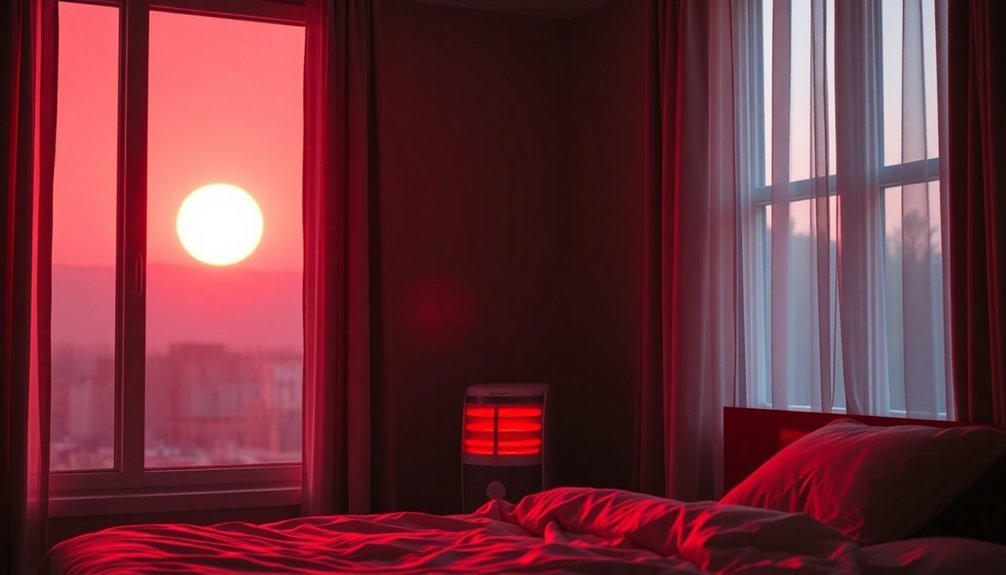
Your body's natural melatonin production peaks at night, making it vital to support this process with the right approaches.
You can boost your sleep quality by aligning your circadian rhythm with natural sleep aids like valerian root, L-theanine, or CBD, which help create ideal conditions for rest.
When combined with proper timing of light exposure, these natural substances can strengthen your body's sleep-wake cycle and enhance your overall sleep experience.
Taking 300 to 600 mg of valerian root before bedtime has been shown to help people fall asleep faster and achieve deeper sleep stages.
Melatonin Production at Night
The natural rhythm of melatonin production forms the cornerstone of quality sleep. Your pineal gland, located in your brain, releases this vital hormone when darkness falls, helping to regulate your sleep-wake cycle.
As the sun sets, your brain signals the pineal gland to increase melatonin production, reaching peak levels approximately seven hours after sunset. Research shows synthetic melatonin supplements are produced in laboratories and are typically safer due to their purity compared to natural sources.
You can optimize your natural melatonin production by understanding these key factors:
- Exposure to morning sunlight stimulates serotonin production, which later converts to melatonin
- Consuming tryptophan-rich foods like turkey, bananas, and peanuts supports melatonin synthesis
- Taking a warm bath before bedtime reduces cortisol levels, allowing melatonin to rise naturally
Your melatonin levels naturally decline in the morning, helping you feel alert upon waking.
If you're struggling with sleep, you might consider melatonin supplementation of 1-5 milligrams about 30 minutes before bedtime. However, it's vital to address lifestyle factors first, as high stress levels and excessive light exposure can disrupt your body's natural melatonin production.
Regular physical activity, though not directly affecting melatonin, can help stabilize your sleep patterns.
Circadian Rhythm Reset
While natural sunlight remains the gold standard for regulating sleep patterns, red light therapy has emerged as a powerful tool for resetting your circadian rhythm. This therapy uses specific wavelengths (630-850 nm) of visible and near-infrared red light to help synchronize your internal clock with the external environment through the suprachiasmatic nucleus (SCN).
You'll get the most benefit by using red light therapy strategically throughout the day. A 20-30 minute session in the morning can boost your alertness and mood, while evening exposure helps trigger natural melatonin production. Extensive research shows that color temperatures above 4000K can significantly suppress melatonin production.
Unlike blue light, which disrupts your sleep-wake cycle, red light works with your body's natural rhythms.
For those dealing with jet lag or shift work disorders, red light therapy offers a non-pharmacological solution to reset your biological clock. The therapy's effectiveness stems from its ability to stimulate melatonin secretion through the retina to the SCN and pineal gland.
When combined with LED devices that alternate between orange and blue wavelengths, you can advance your melatonin production by approximately 1 hour and 20 minutes, making it easier to adjust to new sleep schedules.
Sleep Quality Boost
Natural sleep enhancement extends beyond light therapy, incorporating powerful compounds and practices that work synergistically with your body's sleep mechanisms. When you combine red light exposure with proven sleep-promoting nutrients, you'll create a thorough approach to achieving deeper, more restorative rest.
Consider integrating these science-backed sleep enhancers alongside your red light therapy:
- Magnesium supplementation before bedtime can help relax your muscles and calm your mind, working in harmony with red light's soothing effects.
- Plant-based remedies like valerian root, lavender, and chamomile tea naturally boost your GABA production while promoting relaxation.
- Amino acids such as L-theanine and glycine can reduce stress and help you fall asleep faster when taken before bed.
You'll maximize your sleep quality by creating an environment that supports these natural interventions. Dim your regular lights in the evening, maintain consistent sleep habits, and consider monitoring your sleep patterns with smart technology.
This multi-faceted approach, combined with red light therapy, helps optimize your body's natural sleep-wake cycle while addressing various aspects of sleep quality.
Stress and Cortisol Regulation
Modern life's constant pressures can send cortisol levels through the roof, but red light therapy steps in as a powerful solution for stress management. When you're stressed, your body produces excess cortisol, disrupting your sleep patterns and creating a vicious cycle of fatigue and anxiety.
Red light therapy breaks this cycle by naturally lowering your cortisol levels and activating your body's relaxation response.
Through its effect on your parasympathetic nervous system, red light therapy helps counteract the fight-or-flight response that keeps you on edge. It's particularly effective because it works with your body's endocrine system, supporting both your thyroid and adrenal glands in maintaining proper hormone balance.
You'll find that consistent red light therapy sessions can lead to long-term improvements in your stress resilience. It's a non-invasive approach that you can easily combine with other stress management techniques for enhanced results.
The science backs this up – multiple studies show that red light therapy users experience significant reductions in cortisol levels and improved hormone balance. By regulating your cortisol production, you're not just managing stress better – you're also setting yourself up for improved sleep quality and overall well-being.
Cellular Recovery During Rest
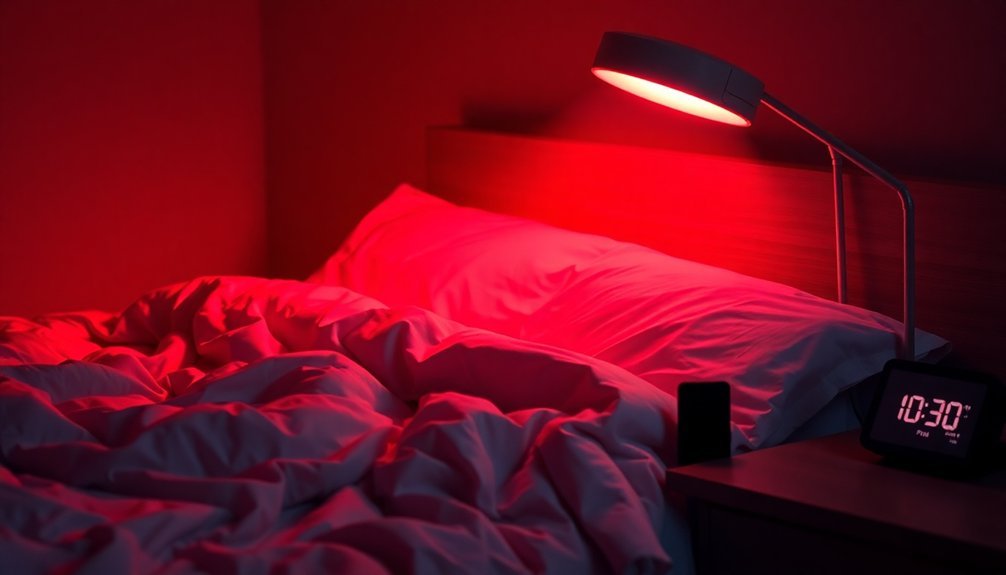
Cells undergo remarkable rejuvenation during your nightly rest, with red light therapy amplifying this natural recovery process. Your body's cells enter a sleep-like state called quiescence, where they can be reactivated for tissue repair when needed.
During this time, cellular recycling functions work to clear out damaged components and maintain cellular health, preventing the irreversible state of senescence.
Your brain's immune cells, known as microglia, become particularly active during sleep, performing critical repair functions and reorganizing neural connections. These cells respond to your body's natural sleep-wake signals, with their repair activities reaching peak effectiveness during your deepest sleep phases.
Key benefits of cellular recovery during sleep include:
- Enhanced lysosomal-autophagy function, which removes cellular waste and reduces stress
- Prevention of cells slipping into a harmful, coma-like state through proper sleep regulation
- Optimization of tissue repair and maintenance through controlled cellular activation
Red light exposure supports these natural processes by promoting cellular energy production and reducing oxidative stress, helping your cells maintain their repair capabilities throughout the night. This targeted approach helps prevent cellular aging while supporting your body's natural recovery mechanisms.
Athletic Sleep Performance Connection
The profound link between sleep and athletic excellence extends far beyond basic rest, with research showing that athletes who consistently get less than 8 hours of sleep face a 70% higher injury risk. When you're an athlete, inadequate sleep doesn't just leave you tired – it compromises your motivation, dulls your reaction time, and increases your perception of pain and exertion during training.
Elite athletes face unique sleep challenges that can derail their performance. Between busy competition schedules, travel demands, and external commitments, getting quality rest becomes increasingly difficult. You'll find that individual athletes tend to sleep and wake earlier than team sport athletes, often getting less overall sleep. Even Olympic athletes experience significant reductions in sleep quality compared to non-athletes.
If you're looking to optimize your athletic performance, there's no substitute for proper sleep. While daytime naps can help improve afternoon power and perception, they won't fully compensate for poor nighttime rest.
That's where red light therapy offers a promising solution. Studies show it enhances sleep quality and boosts melatonin production, particularly beneficial during high-intensity training periods. For athletes seeking a non-invasive way to improve sleep, red light therapy provides a science-backed option.
Brain Wave Optimization
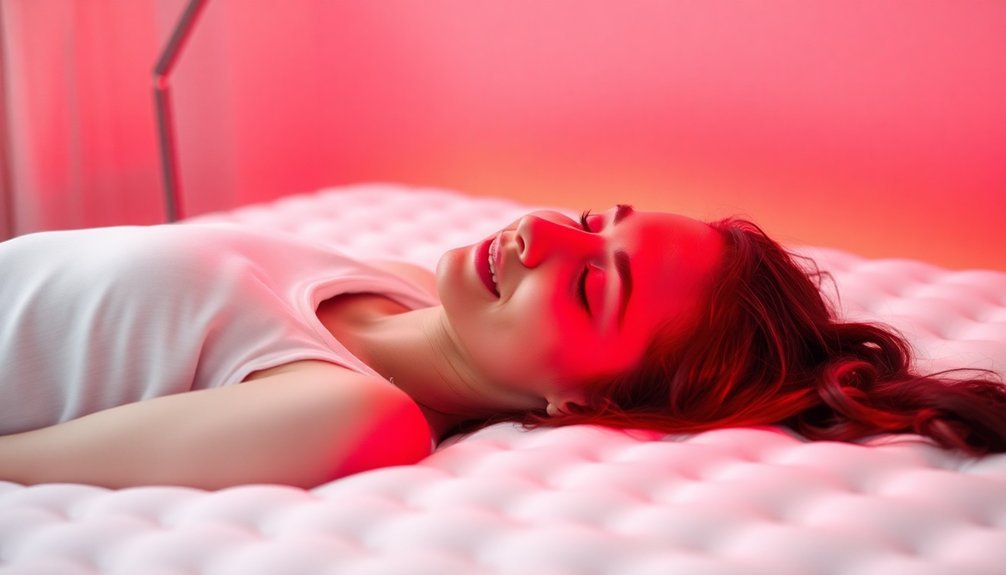
Brainwave patterns hold the key to opening better sleep quality through precise optimization techniques. When you combine red light therapy with targeted brainwave entrainment, you'll enhance your brain's natural ability to shift into deep, restorative sleep.
The 670nm red light wavelength works specifically to boost melatonin production while supporting your circadian rhythm alignment.
Neurofeedback techniques have proven particularly effective when paired with red light exposure. You'll learn to control your brainwave patterns through biofeedback training, leading to improved sleep onset and maintenance. The combination of these approaches helps you achieve ideal brain states for rest.
- Use slow-wave sleep (SWS) music to decrease delta power density and improve functional connectivity
- Practice deep breathing exercises while exposed to red light to enhance relaxation
- Implement progressive muscle relaxation techniques during your pre-sleep red light therapy sessions
Your brain responds particularly well to this optimization approach because it addresses multiple sleep-promoting mechanisms simultaneously. Unlike blue light, which disrupts your sleep cycle, red light therapy naturally supports your brain's shift to sleep while entrainment techniques guide your brainwaves into patterns conducive to deep, invigorating rest.
Inflammation Reduction Effects
Deep within your body's cells, red light therapy triggers a powerful cascade of anti-inflammatory responses that directly impact your sleep quality. When you expose your body to red light wavelengths between 630-660 nm, it stimulates ATP production, reducing oxidative stress and enhancing cellular energy levels that promote better sleep.
You'll find that red light therapy works on multiple levels to combat inflammation. It boosts circulation, decreases cortisol levels, and supports the production of essential sleep hormones like serotonin and melatonin.
If you're dealing with conditions like arthritis or restless leg syndrome, you'll benefit from the therapy's ability to reduce pain and inflammation that often disrupt sleep patterns.
Clinical evidence supports these benefits, with studies showing significant improvements in sleep quality among various groups, including athletes and individuals with traumatic brain injuries.
You can maximize these benefits by using red light therapy devices in the evening, allowing the anti-inflammatory effects to help regulate your circadian rhythm. Whether you choose targeted treatment or whole-body exposure, consistent use of red light therapy provides a drug-free solution to address inflammation-related sleep disturbances.
Treatment Timing and Consistency
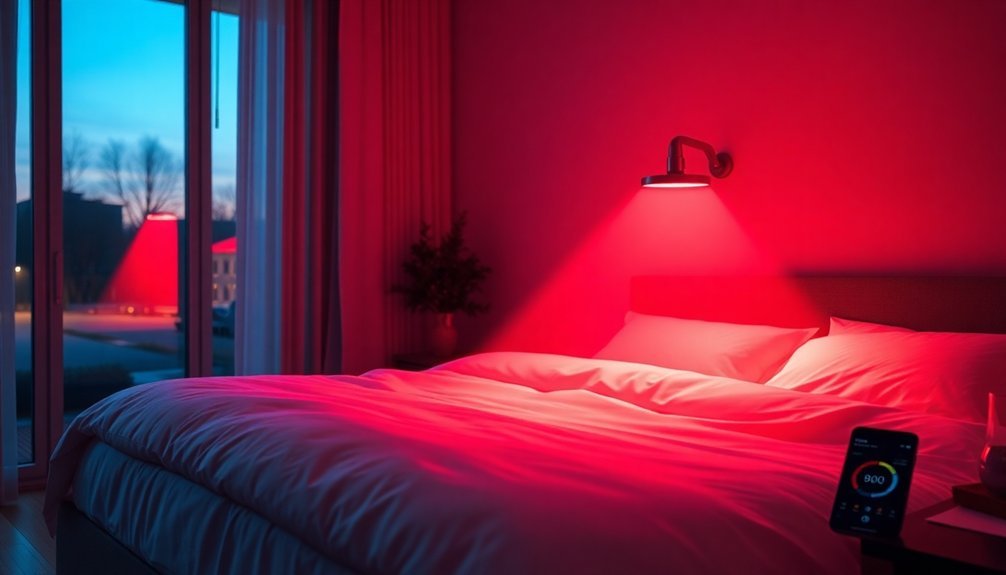
Maximizing red light therapy's sleep-enhancing benefits requires careful attention to timing and consistency. You'll get the best results by using your device 30 minutes to 2 hours before bedtime, as this timing mimics natural sunset and helps regulate your circadian rhythm.
For maximum effectiveness, position your device about 2 feet away and aim for a 10-minute session, though even 3-minute sessions can provide benefits.
To establish a strong sleep routine, incorporate red light therapy 3-7 times per week. Avoid morning sessions if your goal is better sleep, as they can suppress melatonin production. Instead, make evening sessions part of your wind-down ritual to signal your body it's time to rest.
Key elements for successful treatment include:
- Maintaining consistent treatment times to train your brain to associate red light with sleep preparation
- Creating a calm environment during sessions to enhance relaxation benefits
- Adapting the therapy to your comfort level, such as using the device on your back if you have sensitive eyes.
Frequently Asked Questions
How Long Does Red Light Therapy Take to Show Noticeable Sleep Improvements?
You'll typically notice sleep improvements from red light therapy within 2-3 weeks of consistent use. While you might experience immediate effects like reduced inflammation, lasting sleep benefits require regular sessions at least 3 times weekly.
Can Red Light Therapy Be Combined With Other Sleep Medications?
You can combine red light therapy with sleep medications, but you'll need to consult your healthcare provider first. There's limited research on interactions, so professional guidance is essential for safe and effective treatment.
Are There Specific Wavelengths of Red Light That Work Better?
Yes, you'll get the best sleep benefits using red light between 630-700nm and near-infrared light between 700-900nm. The longer wavelengths penetrate deeper into your tissues for better therapeutic effects.
Does the Distance From Red Light Devices Affect Their Effectiveness?
Yes, distance substantially affects your red light therapy results. You'll get maximum benefits at 12-24 inches away. For sleep benefits, keep the device 18-36 inches from your body during treatment sessions.
Can Red Light Therapy Help With Jet Lag Recovery?
Yes, red light therapy can help you recover from jet lag by regulating your circadian rhythm. You'll find it easier to adjust to new time zones and improve your sleep quality while traveling.
In Summary
You'll find that consistently using red light therapy before bed can revolutionize your sleep quality. By incorporating these science-backed methods into your nightly routine, you're helping your body naturally regulate melatonin, reduce stress, and optimize cellular repair. Don't wait to transform your sleep – start with just 15-20 minutes of red light exposure each evening, and you'll likely notice improvements within two weeks.

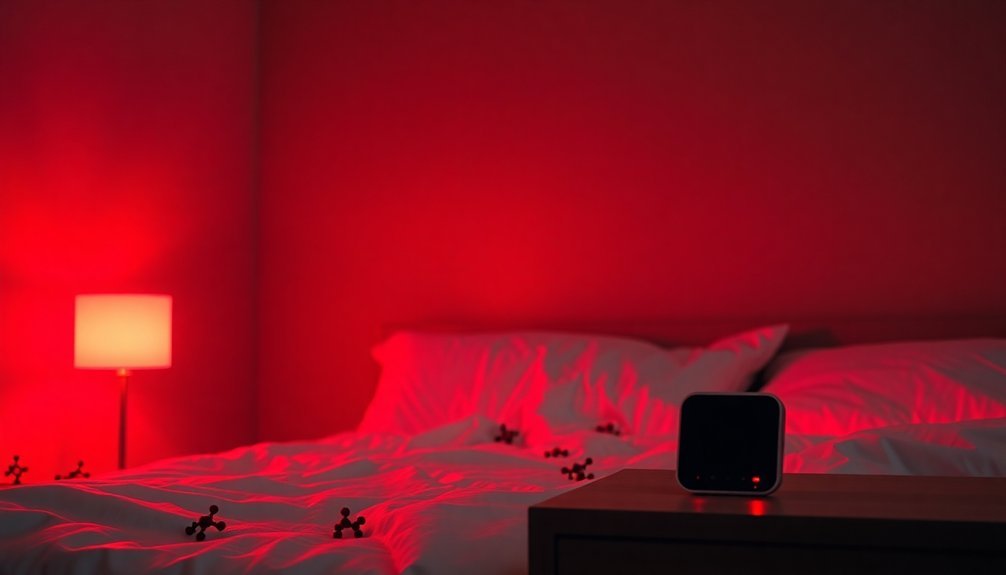



Leave a Reply